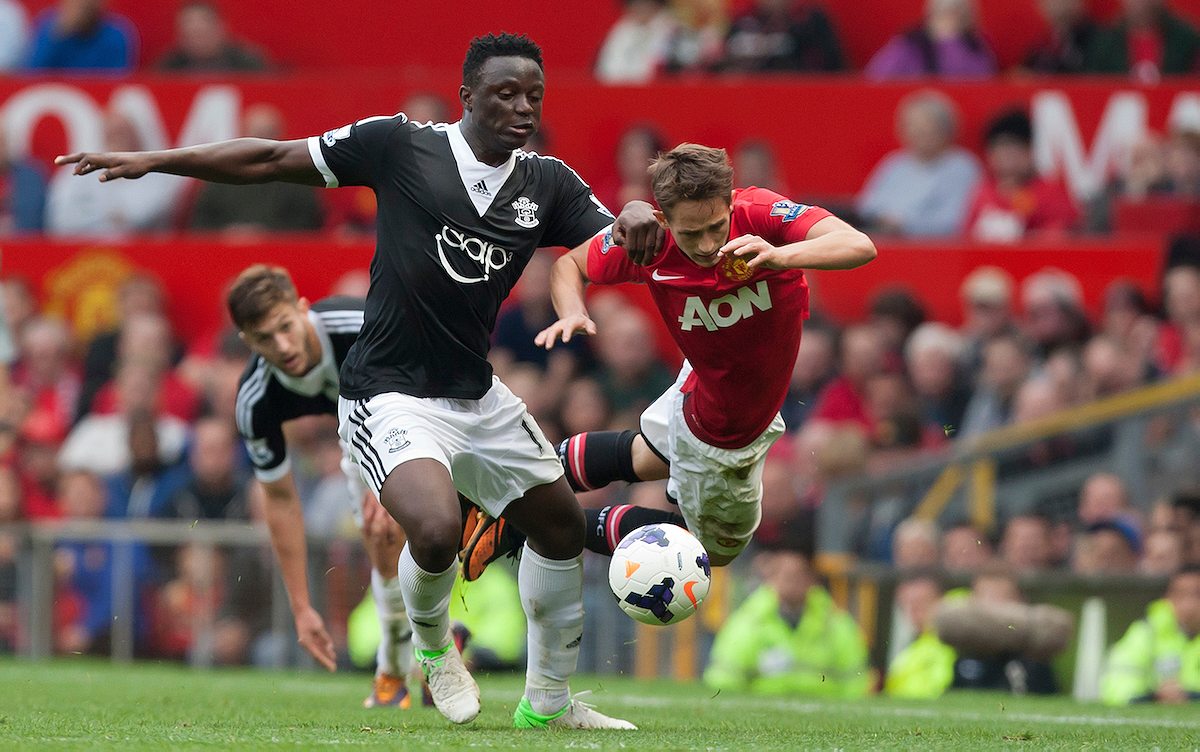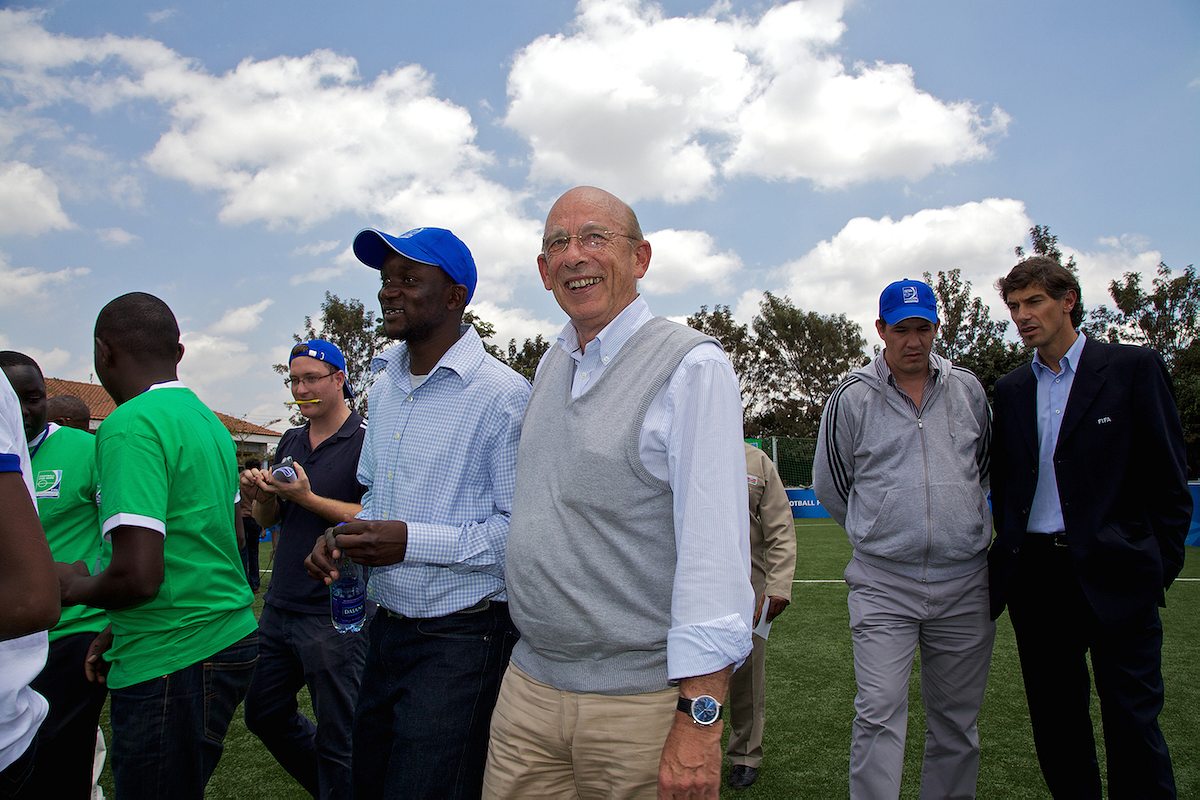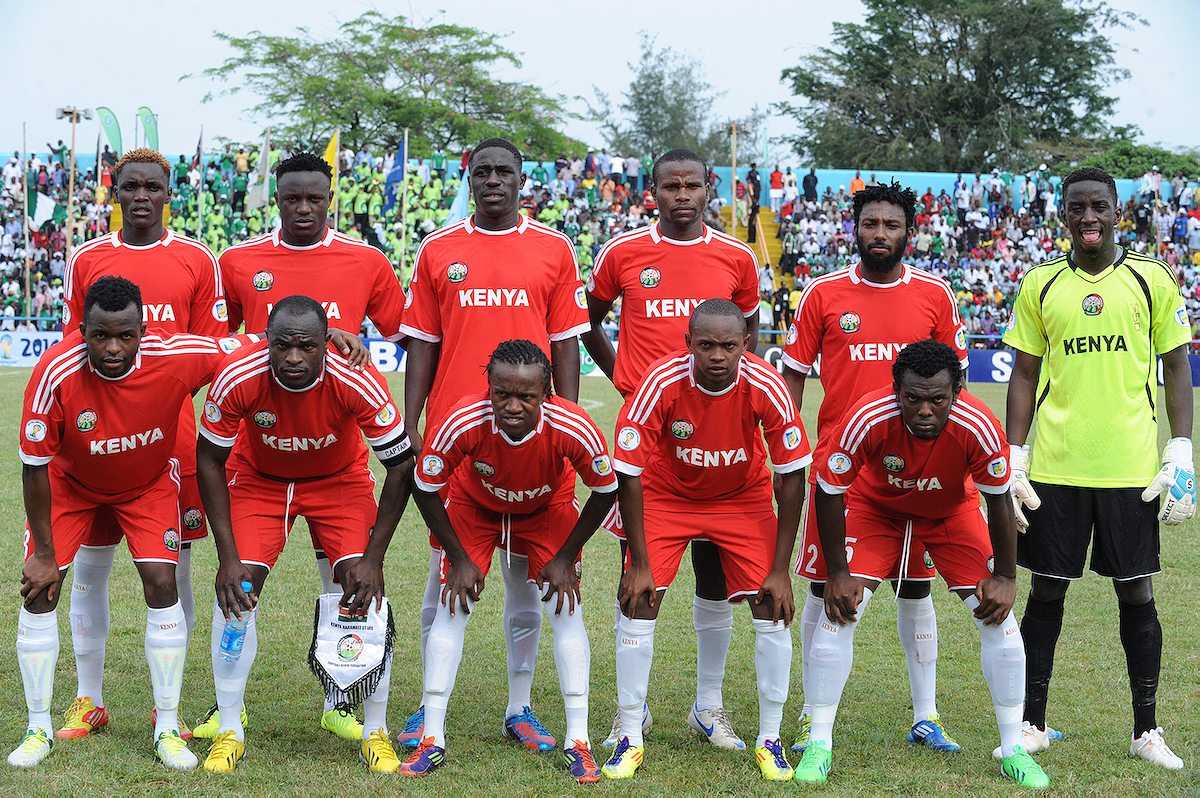After years of mismanagement, Kenyan soccer is finally coming into its own.
Weaving through downtown Nairobi on a recent Saturday afternoon, I entered Lazaru’s Inn, a small bar in the heart of the city centre, to join the Kenya Arsenal Fan Club for the Arsenal v. Everton FA Cup quarterfinal match. By kickoff, there are over 100 Arsenal supporters sitting shoulder to shoulder; the rowdiest contingent is gathered around a screen in the back. Fans wearing red and yellow Arsenal jerseys with names and customized messages such as “The Unbeatable” and “Verminator,” for Arsenal captain Thomas Vermaelen, emblazoned across the back, are already shushing people. Enthusiasm turns to dismay when the SuperSport channel is changed to the West Brom vs. Manchester United match. The crowd in the back heaves, and people begin hurling insults towards the bar; one fan mutters that the video jockey is an ignorant Manchester United fan. The channel is changed back in enough time for the crowd to roar at Arsenal’s goal in the sixth minute.
Mania for the English Premier League is a nationwide phenomenon that isn’t hindered by ethnic or class divisions; both the country’s poorest and its elite can be found watching a match or arguing its merits. Kenyan football fans primarily rally around Arsenal and Manchester United, though there are a substantial number of Liverpool, Chelsea and, increasingly, Manchester City fans.
The fanaticism has reached, in several high-profile cases, a deadly level. A couple of weeks before Christmas John Macharia, 28, leapt off his seventh-floor apartment balcony in Nairobi and plummeted to his death. Macharia had been a devoted follower of Manchester United, and he killed himself shortly after its shock 1-0 defeat against Newcastle at Old Trafford. Suleiman Omondi, a 29-year-old Arsenal fan, hung himself after his team suffered a defeat against Manchester United, in 2009. After Macharia’s death, Nairobi’s county police commander Benson Kibue urged Kenyan soccer fans to support local teams rather than glamorous European sides such as Manchester United. “They should enjoy the matches,” he said “but they should not commit suicide since life is very precious.”
Kenyans understand the language of football, we just respect foreign football more than we respect our own.
The Arsenal-Manchester United rivalry dominates social media. Arsenal fans call out “Manure” fans on their performance this season, and Manchester United fans respond with taunts about how Kenyan starlet “Lupita Nyong’o has won more trophies than Arsenal in the last nine years.”
That the vast majority are Arsenal and Manchester United fans is no coincidence. As the local league disintegrated throughout the 90s, people sought their sports entertainment in the English Premier League and Bundesliga highlights shown on local TV. By the end of the 90s, the broadcast of full Premier League matches on Kenya’s SuperSport channel tipped the balance, and as people grew increasingly disenchanted with the local football scene, the fervor for the English league grew.
“During that entire period, Kenyan football was dead, and English football became religion,” says Carol Radull, a leading sports reporter. “I think it was Samuel Eto’o who said ‘you can go to any village, in any part of Africa, kick a ball and make an instant friend.’ Kenyans understand the language of football, we just respect foreign football more than we respect our own.”
Kenyan football has a tainted history of wrangling, scandal and corruption; it was banned by FIFA in 2004 and 2006 because of political meddling. Steve Bloomfield, journalist and author of Africa United: How Football Explains Africa summarizes the systemic breakdown in his chapter on the Kenyan national team, the Harambee Stars:
“It was a story of stolen gate receipts, missing FIFA funds and institutional match-rigging. Senior figures in the football administration had been charged with corruption but Kenya’s notoriously creaking justice system had failed to prosecute anyone… The mix of money and power led to a succession of rows over who should control football, arguments which have had a terrible effect on the game itself.”
Just follow the acronyms: The Kenya Football Federation (KFF) became synonymous with corruption and mismanagement, and was rebranded into Football Kenya Limited (FKL,) it is here that the structure becomes increasingly entangled with the KFF and the FKL running parallel for a period of time, before the governing body was once again reimagined as the Football Kenya Federation (FKF)— its current manifestation. The underlying issues however, have remained.

Bob Munro, 71, is completely at ease; his sweater is draped over his shoulders, and his shirtsleeves are rolled up. The waiters, at the popular local restaurant where we have met, refer to him by first name. At first glance, Munro doesn’t strike you an authority on Kenyan football; he has a kindly smile, his glasses are the proper old school kind (round, no frames) and, well, he’s white.
Munro, a native of St. Catharines, Ontario, has come a long way from the ice hockey and baseball of his youth, and is now one of the go-to people on Kenyan football. Munro, who moved to the country as an advisor to the United Nations Environmental Program and UN Habitat in 1985, founded the Mathare Youth Sports Association (MYSA) in 1987, and the professional team Mathare United FC in 1994. Both are based in Mathare, one of Nairobi’s sprawling slums, which are home to at least 60% of Nairobi residents. MYSA, a global pioneer in sports for development, was the only league in the stands to have a column for ‘garbage cleaning’ in the points table; the association now has over 1,800 youth football teams, and over 25,000 boys and girls who develop their community through environmental cleanup, HIV/AIDS awareness, and literacy programs. MYSA and Mathare United FC were amongst the 165 nominees for the Nobel Peace Prize in 2003, and are expected to defend their FIFA Football for Hope championship title in Brazil this year.
When I meet up with him at Rustic Bistro, Munro explains what went wrong with Kenyan football, and why the need for independent youth football was so great. “There was a culture of corruption deeply embedded, which was in favor of a few teams at the expense of the others, and where the football officials basically exploited the clubs financially, without attracting money to invest in developing the game,” Munro says.
He adds that besides marriage, and in the worst cases, death, there are only a couple of avenues out of the slums; education and sports. The culture of corruption compromises opportunities for young people in both.
“[Youth] can’t use their football skills to get their families out of poverty, because the football officials are mismanaging the league and stealing the money, but they are also stealing their future. That’s the worst part.”

The corruption, which was basically extortion, made it virtually impossible for Mathare United and other teams to play a fair game, if they managed to play at all. Throughout the 1990s the federation imposed exorbitant costs on the teams; everything from an extraneous $150-$250 membership fee to the approximately $100 per player for ‘players cards’ which were basically pieces of cardboard that players had to fill and attach a photo too. There were additional fees to register for cup finals, and more money required for special players cards for each particular cup.
All this, and teams stood no chance of winning matches away from home.
“The corruption in Kenyan football was so bad, referees would give a penalty to the home team to win a match or get a draw,” Munro says. The situation was dire, but in 1998 the Mathare United team had finally made it into the nationwide league, and they weren’t about to miss out on their opportunity. A friend of Munro’s donated a JVC camera and battery pack to the team, and they went on the offensive.
“In 1998 our team manager was the most fit person on the team,” Munro remembers, laughing. “At the prematch he would go shove [the camera] in the referee’s face, and during the match he was running up and down the field with this camera and battery pack.” The referees, unused to being on video, refrained from blatant rigging, and the team garnered enough points to move forward.
“That camera was broken, it didn’t work,” Munro adds with a conspiratorial grin. “But in the end, it did work.”
There has been one fundamental change in local football: the formation of the Kenya Premier League.
The FKF remains far from exemplary; as recently as July 2013, BBC reported that the Ethics and Anti-Corruption Commission was investigating the FKF for the alleged misappropriation of $410,000, and three Kenyan referees are currently under investigation for fixing a club match in South Africa in 2010. However, there has been one fundamental change in local football: the formation of the Kenya Premier League.
The formation of the league was messy and drawn out. The process began in 2003, when 12 of the top clubs, including Mathare United, resigned from the KFF. The teams had tired of being sidelined after every federation election, and so they set up their own company, and even hosted a “Transparency Cup” to combat corruption, thereby effectively launching the Kenya Premier League. Soon after, FIFA admonished them for being a “renegade league” and told them they had to go back to the federation. In the subsequent years however, after recognizing the league’s competence, and in an effort to overcome the corruption of the federation, FIFA supported the clubs’ decision to retain some autonomy. The Kenya Premier League returned to the fold as an affiliate, with a league run by the clubs, like the English Premier League and South Africa’s Premier Soccer League.
For teams that had once trampled on each other to stay in favor with the federation, and therefore in favor with the referees, the balance of power had shifted. As Munro, who was also one of the league’s founding members, describes it, there was fair play in the new league, and a strict ‘no receipt, no expenditure’ rule. The league had no money, and devised a simple system: the home team paid the referees and kept the gate receipts. Their defining ideology cut straight to the point: those that produce football on the field should make the decisions off the field.
“We’re only opponents for 90 minutes twice a year, the rest of the time we have the same problems, we should be sharing with each other and helping each other, and not let others divide and rule us,” Munro passionately adds.
By 2007-2008 season, the local football scene had changed entirely: football had become professional, and before long, SuperSport was so impressed it negotiated the league’s television rights. Tragically, 2007-2008 was also the year everything changed for Kenya; violence erupted after a disputed election, and the country was in flames. Over a thousand people were killed in the violence and countless others displaced.
In an effort to promote national unity, the Kenya Premier League stepped in to fund and co-chair the national team, the Harambee Stars, in the run up to the World Cup qualifiers. By May 2008 both the government, which was struggling to support the hundreds of thousands of internally displaced people, and the FKF had said they could not afford to support the national team. With a loan of approximately $150,000, the Kenya Premier League shared the management of the national team with a reluctant FKF.
The league unanimously selected Mathare United coach Francis Kimanzi to coach the national team, and in a single season Kenya rose 52 places in the FIFA ranking from 120th to 68th. This success was short-lived, and with it the hopes that Kenyan players would be eligible to play in Britain; where a national ranking of under 70 is required in order for players to qualify for direct transfer. The federation unceremoniously dismissed Kimanzi in 2008 after he refused to take his players to a lucrative friendly in Egypt. The federation reclaimed control of the national team, and before long Kenya had plummeted in the rankings.
The league however, has continued to grow in strength and popularity. Salaries have gone from an abysmal $35-$58 a month to $233-$349, with the league hoping to reach $814- $1,162, in order to be regionally competitive. The total annual budget of Kenya’s major teams AFC Leopards and Gor Mahia, community based teams founded along ethnic lines, but which have become increasingly diverse with the recent professionalization of the sport, used to be $58,000-$69,000 and have increased tenfold. The two teams used to draw an average of about 2000 people to the stadium in the mid to late 1990s, that number is now an average of 10,000-15,000 fans in the stadium during a derby match.
Viewership of local league matches has also quadrupled since SuperSport bought the rights to broadcast the matches, according to sportscaster Radull. A large SuperSport rig is a staple at all premier league matches.

On a Sunday in late March, one such van is parked outside the Mombasa County Stadium. It is half time, and the stadium is packed. Kenyan football heavyweights Gor Mahia are playing against hometown favorites Bandari in the Kenya Premier League. The score is 1-1, it is 90 degrees, and the humidity is getting to everybody. Gor Mahia’s green and white can be seen across the stands, fans are wearing all kinds of hats: baseball caps (one even has a green and white Mohawk fashioned from straw), cowboy hats, straw hats, and even a green helmet. While Gor Mahia’s fans have made their loyalty as apparent as possible; Mombasa residents have also shown up in force, a sea of blue supporting their home team against the giants of Kenyan football.
The start of the second half is delayed due to what the announcers are calling a crowd invasion; Bandari supporters have spilled past the mesh wire perimeter, and over onto the pitch. People mill about, in what is hardly an invasion, before moving back to the stands. As the game resumes, Gor Mahia fans begin chanting and clapping, and before long Bandari fans wielding vuvuzelas and flags are making an equal amount of noise. Groans of disappointment at almost goals, and shouts of dismay over fouls, of which there are many, fill the air. Bandari’s Victor Majid scores the team’s second goal in the 74th minute, and the crowd begins stomping on the wooden beams, cheering and chanting, and waving flags. As far as they are concerned, the game is over. The remainder of the match is an exercise in stalling from Bandari; kicking the ball out, passing it to their goalkeeper from afar, and taking as many measures as they can to maintain possession of the ball. Gor Mahia fans are muted, worried, as the game draws to a close. A large contingent of green and white are streaming out of the stands before the final whistle is blown. It is yet another successful match, regardless of the winner: everything a league could hope for.
Kenyan football can be a billion dollar industry if it attracts the right kind of investment.
The Kenyan renaissance however, is still its early stages. Competitors are still far ahead in terms of investment, Tanzanian clubs have 7-8 times the annual budget of Kenya’s top teams, and clubs like Congo’s TP Mazembe and Egypt’s Al Ahly and Zamalek have annual budgets of over $11 million, putting them at 30 to 40 times more than the most well-funded Kenyan teams.
“We’re just starting down that road,” says Munro. He argues that Kenyan football can be a billion dollar industry if it attracts the right kind of investment. This, he says, is where the fanaticism around English football becomes problematic.
“Yes, the EPL moved into the vacuum created by the poor state of our football in the 1990s, but they have dominated our TV screens and fans are identifying with foreign teams rather than Kenyan teams, and they are even partnering with local banks who could be investing in local football,” says Munro, referring to the Arsenal debit cards launched in Kenya and Uganda by Imperial Bank last year. “They are siphoning off potential investment in local football, and this issue has to be addressed in global football, especially if by acting that way they destroy football in Africa.”
Back at Lazaru’s Inn, the chanting, stomping and high fives after Arsenal’s fourth goal demonstrate that no matter how fast or far Kenyan football has become, the English Premier League takes precedence, and that although its arrival may have filled a void, it is loved in its own right.
“Kenyans love football,” says an Arsenal fan named Kennedy Gitau, looking jubilant after the victory. “Ever since the EPL came to Kenya, the local game has transformed. For Kenyan football to grow, the clubs will have to look for their fans, and not wait for their fans to come to them.”
[Header image by: Michele Sibiloni/AFP/Getty Images]
